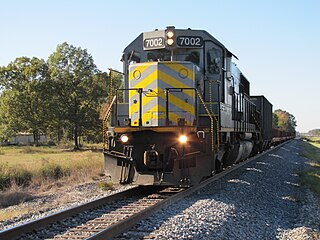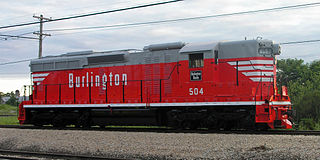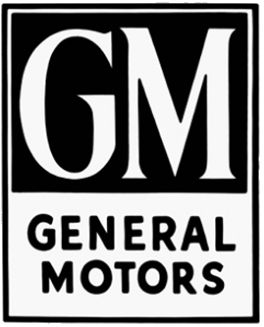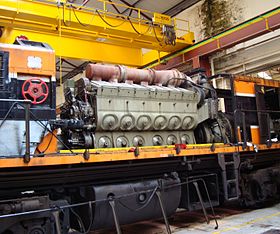
A four-strokeengine is an internal combustion (IC) engine in which the piston completes four separate strokes while turning the crankshaft. A stroke refers to the full travel of the piston along the cylinder, in either direction. The four separate strokes are termed:
- Intake: Also known as induction or suction. This stroke of the piston begins at top dead center (T.D.C.) and ends at bottom dead center (B.D.C.). In this stroke the intake valve must be in the open position while the piston pulls an air-fuel mixture into the cylinder by producing a partial vacuum in the cylinder through its downward motion.
- Compression: This stroke begins at B.D.C, or just at the end of the suction stroke, and ends at T.D.C. In this stroke the piston compresses the air-fuel mixture in preparation for ignition during the power stroke (below). Both the intake and exhaust valves are closed during this stage.
- Combustion: Also known as power or ignition. This is the start of the second revolution of the four stroke cycle. At this point the crankshaft has completed a full 360 degree revolution. While the piston is at T.D.C. the compressed air-fuel mixture is ignited by a spark plug or by heat generated by high compression, forcefully returning the piston to B.D.C. This stroke produces mechanical work from the engine to turn the crankshaft.
- Exhaust: Also known as outlet. During the exhaust stroke, the piston, once again, returns from B.D.C. to T.D.C. while the exhaust valve is open. This action expels the spent air-fuel mixture through the exhaust port.
The GM Ecotec engine, also known by its codename L850, is a family of all-aluminium inline-four engines, displacing between 1.4 and 2.5 litres. Confusingly, the Ecotec name was also applied to the final DOHC derivatives of the previous GM Family II engine; the architecture was substantially re-engineered for this new Ecotec application produced since 2000. This engine family replaced the GM Family II engine, the GM 122 engine, the Saab H engine, and the Quad 4 engine. It is manufactured in multiple locations, to include Spring Hill Manufacturing, in Spring Hill, Tennessee, with engine blocks and cylinder heads cast at Saginaw Metal Casting Operations in Saginaw, Michigan.

Power Stroke, also known as Powerstroke or PowerStroke, is the name used by a family of diesel engines for trucks produced by Ford Motor Company and Navistar International for Ford products since 1994. Along with its use in the Ford F-Series, applications include the Ford E-Series, Ford Excursion, and Ford LCF commercial truck. The name was also used for a diesel engine used in South American production of the Ford Ranger.

The E9 is a 2,400-horsepower (1,790 kW), A1A-A1A passenger train-hauling diesel locomotive built by General Motors' Electro-Motive Division of La Grange, Illinois, between April 1954 and January 1964. 100 cab-equipped A units were produced and 44 cabless booster B units, all for service in the United States. The E9 was the tenth and last model of EMD E-unit and differed from the earlier E8 as built only by the newer engines and a different, flusher-fitting mounting for the headlight glass, the latter being the only visible difference. Since some E8s were fitted with this, it is not a reliable way to distinguish the two. The E9 has two 1,200 hp (895 kW), V12 model 567C engines, each engine driving one generator to power two traction motors.

EMD E-units were a line of passenger train streamliner diesel locomotives built by the General Motors Electro-Motive Division (EMD) and its predecessor the Electro-Motive Corporation (EMC). Final assembly for all E-units was in La Grange, Illinois. Production ran from May 1937, to December, 1963. The name E-units refers to the model numbers given to each successive type, which all began with E. The E originally stood for eighteen hundred horsepower, the power of the earliest model, but the letter was kept for later models of higher power.

EMD F-units are a line of diesel-electric locomotives produced between November 1939 and November 1960 by General Motors Electro-Motive Division and General Motors-Diesel Division. Final assembly for all F-units was at the GM-EMD plant at La Grange, Illinois, and the GMDD plant in London, Ontario. They were sold to railroads throughout the United States, Canada and Mexico, and a few were exported to Saudi Arabia. The term F-unit refers to the model numbers given to each successive type, all of which began with the letter F. The F originally meant "fourteen", as in 1,400 horsepower (1,000 kW), not "freight". Longer EMD E-units for passenger service had twin 900-horsepower (670 kW) diesel engines. The E meant "eighteen" as in 1,800 horsepower (1,300 kW). Similarly, for early model EMD switchers, S meant "six hundred" and N meant "nine hundred horsepower".

The EMD F9 is a 1,750 horsepower (1,300 kW) Diesel-electric locomotive produced between February 1953 and May 1960 by the Electro-Motive Division of General Motors (EMD) and General Motors Diesel (GMD). It succeeded the F7 model in GM-EMD's F-unit sequence. Final assembly was at GM-EMD's La Grange, Illinois plant. The F9 was also built in Canada by General Motors Diesel at their London, Ontario plant. A total of 101 cab-equipped lead A units and 156 cabless booster B units were built. The F9 was the fifth model in GM-EMD's highly successful "F" series of cab unit diesel locomotives.

The EMD SD40-2 is a 3,000-horsepower (2,200 kW) C-C diesel-electric locomotive built by EMD from 1972 to 1989.

The EMD SD50 is a 3,500-horsepower (2,610 kW) diesel-electric locomotive built by General Motors Electro-Motive Division. It was introduced in May 1981 as part of EMD's "50 Series"; production ceased in January 1986. The SD50 was a transitional model between EMD's Dash 2 series which was produced throughout the 1970s and the microprocessor-equipped SD60 and SD70 locomotives. A total of 431 were built.

The EMD SD24 was a 2,400 hp (1,800 kW) six-axle (C-C) diesel-electric locomotive built by General Motors' Electro-Motive Division of La Grange, Illinois between July 1958 and March 1963. A total of 224 units were built for customers in the United States, comprising 179 regular, cab-equipped locomotives and 45 cabless B units. The latter were built solely for the Union Pacific Railroad.

Electro-Motive Diesel is a brand of diesel-electric locomotives, locomotive products and diesel engines for the rail industry. Formerly a division of General Motors, EMD is now owned by Progress Rail, a subsidiary of Caterpillar Inc. Electro-Motive Diesel traces its roots to the Electro-Motive Engineering Corporation, founded in 1922 and purchased by General Motors in 1930. After purchase by GM, the company was known as GM's Electro-Motive Division. In 2005, GM sold EMD to Greenbriar Equity Group and Berkshire Partners, and in 2010, EMD was sold to Progress Rail. Upon the 2005 sale, the company was renamed to Electro-Motive Diesel.

The EMD SW900 is a diesel switcher locomotive built by General Motors Electro-Motive Division and General Motors Diesel (GMD) between December 1953 and March 1969. Power was provided by an EMD 567C 8-cylinder engine that generated 900 horsepower (670 kW). Built concurrently with the SW1200, the eight-cylinder units had a single exhaust stack. The last two SW900s built by GMD for British Columbia Hydro were built with 8 cylinder 645E engines rated at 1,000 horsepower (750 kW).

The EMD 567 is a line of large medium-speed diesel engines built by General Motors' Electro-Motive Division. This engine, which succeeded Winton's 201A, was used in EMD's locomotives from 1938 until its replacement in 1966 by the EMD 645. It has a bore of 8+1⁄2 in (216 mm), a stroke of 10 in (254 mm) and a displacement of 567 cu in (9.29 L) per cylinder. Like the Winton 201A, the EMD 645 and the EMD 710, the EMD 567 is a two-stroke engine.

The EMD 710 is a line of diesel engines built by Electro-Motive Diesel. The 710 series replaced the earlier EMD 645 series when the 645F series proved to be unreliable in the early 1980s 50-series locomotives which featured a maximum engine speed of 950 rpm. The EMD 710 is a relatively large medium-speed two-stroke diesel engine that has 710 cubic inches displacement per cylinder, and a maximum engine speed of 900 rpm.

A two-stroke diesel engine is a diesel engine that uses compression ignition in a two-stroke combustion cycle. It was invented by Hugo Güldner in 1899.

The EMD GT26 Locomotive Series made their debut in 1967 after the rise in popularity of the American EMD SD40. Designed to meet most First World, Second World and Third World countries, the GT26 Series were now equipped with a turbocharged high horsepower EMD 645 Series engine as well as six axle HT-C trucks to provide better traction effort at slow speeds. Based on customer input, the GT26 Series would be defined by various designations that suit the customer's railway operations.
An electronically controlled unit injector (EUI) is a unit injector (UI) with electronic control. It performs the same function as a conventional unit injector in an internal combustion engine, such as in an on-road or off-road vehicle or a diesel-electric locomotive. The pressurized delivery of fuel is camshaft-driven, but the timing of the injector's internal operations are controlled by the engine control unit so as to achieve certain advantages.

An internal combustion engine is a heat engine in which the combustion of a fuel occurs with an oxidizer in a combustion chamber that is an integral part of the working fluid flow circuit. In an internal combustion engine, the expansion of the high-temperature and high-pressure gases produced by combustion applies direct force to some component of the engine. The force is typically applied to pistons, turbine blades, a rotor, or a nozzle. This force moves the component over a distance, transforming chemical energy into kinetic energy which is used to propel, move or power whatever the engine is attached to.
The EMD 1010 or EMD 265 is a line of four-stroke diesel engines manufactured by Electro-Motive Diesel. The precursor to the 1010 was introduced around 1998 as the 265H or H-Engine. The H-engine was initially designed for use as a 6,300 hp (4,700 kW) 16 cylinder, the EMD SD90MAC; however, the early engines were found to be explosive, and unsuccessful in the market, with the proven EMD 710 2-stroke design being preferred. The EMD four-stroke engine was resurrected in 2015 to meet EPA Tier 4 emissions regulations.

The Cleveland Diesel Engine Division of General Motors (GM) was a leading research, design and production facility of diesel engines from the 1930s to the 1960s that was based in Cleveland, Ohio. The Cleveland Diesel Engine Division designed several 2 stroke diesel engines for submarines, tugboats, destroyer escorts, Patapsco-class gasoline tankers and other marine applications. Emergency generator sets were also built around the Cleveland Diesel and were installed in many US warships. The division was created in 1938 from the GM-owned Winton Engine Corporation and was folded into the GM Electro-Motive Division in 1962. The engines continue in use today on older tugs.


















